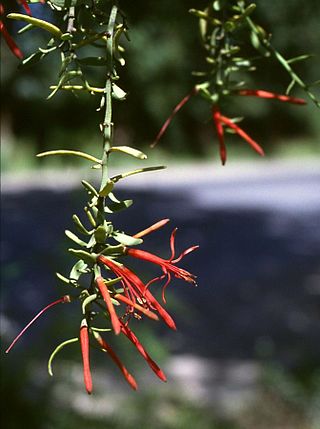
Loranthaceae, commonly known as the showy mistletoes, is a family of flowering plants. It consists of about 75 genera and 1,000 species of woody plants, many of them hemiparasites. The three terrestrial species are Nuytsia floribunda, Atkinsonia ligustrina, and Gaiadendron punctatum Loranthaceae are primarily xylem parasites, but their haustoria may sometimes tap the phloem, while Tristerix aphyllus is almost holoparasitic. For a more complete description of the Australian Loranthaceae, see Flora of Australia online., for the Malesian Loranthaceae see Flora of Malesia.
Daniel Oliver, FRS was an English botanist.

Tapinanthus is a genus of mistletoe in the family Loranthaceae, native to Africa. The name of the genus is derived from the Greek tapeinos meaning "low" or "humble" and anthos meaning flower.

Amyema is a genus of semi-parasitic shrubs (mistletoes) which occur in Malesia and Australia.

Korthalsella is a genus of flowering plants in the sandalwood family, Santalaceae. It contains about 25 species distributed in Asia, Africa, Australia, New Zealand, and some Pacific Islands.

Lysiana is a genus of hemiparasitic shrubs endemic to Australia, in the family Loranthaceae.

Amyema quandang is a species of hemi-parasitic shrub which is widespread throughout the mainland of Australia, especially arid inland regions, sometimes referred to as the grey mistletoe.

Dendrophthoe is a genus of hemiparasitic shrubs found in Asia and Australia known as mistletoes. The genus was described by German naturalist Carl Friedrich Philipp von Martius in 1830. Species in this genus have a variety of reported uses in the medical traditions of the region, most notably in Nepal.

Decaisnina is a genus of semi-parasitic shrubs (mistletoes) that occur in Australia. The type species is D. glauca. Around thirty species are known, found from northern Australia to Tahiti and the Philippines.
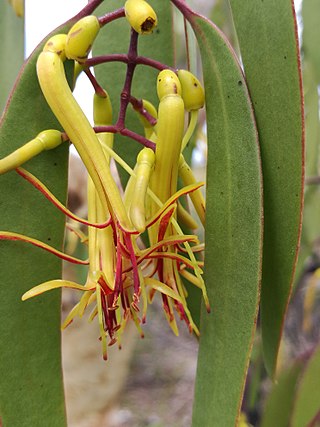
Muellerina is a genus of parasitic aerial shrubs in the family Loranthaceae.
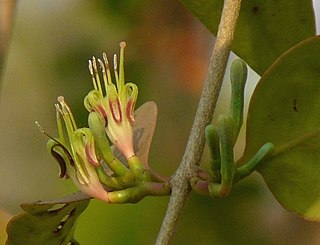
Macrosolen is a genus of plants in the family Loranthaceae. It includes about 83 species all over the world with ca. 40 species widely distributed in tropical South and Southeast Asia. Some species were described by de Loureiro, Lecomte, Danser (1938) and Hô (2003).

Tristerix aphyllus is a holoparasitic plant species of the genus Tristerix in the family Loranthaceae. It is endemic to Chile. T. aphyllus is sometimes called the "cactus mistletoe." It should not be confused with the mistletoe cactus, which is an epiphytic cactus, and not a mistletoe.
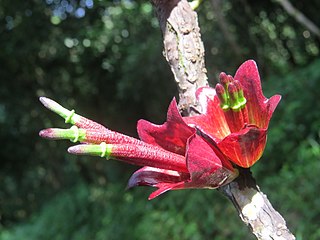
Tolypanthus is a genus of plants in the family Loranthaceae.

Amylotheca is a genus of hemi-parasitic aerial shrubs in the family Loranthaceae, found in Borneo, Malaysia, New Caledonia, New Guinea, Australia, Sumatra, Thailand, Vanuatu, and Philippines
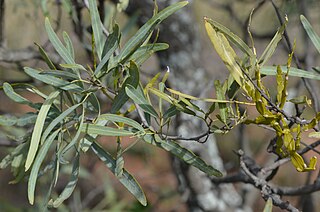
Korthalsella rubra is a flowering plant in the Santalaceae (sandalwood) family, formerly placed in the Viscaceae.
Polythecanthum cambodianum is a species of flowering plant belonging to the family Ochnaceae. It is endemic to Cambodia. It is the sole species in genus Polythecanthum.
Erianthemum is a genus of flowering plants belonging to the family Loranthaceae.
Lepeostegeres is a genus of flowering plants belonging to the family Loranthaceae.

Ligaria is a genus of flowering plants belonging to the family Loranthaceae.
Septulina is a genus of flowering plants belonging to the family Loranthaceae.













